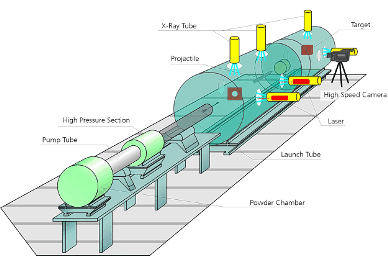An impact experiment in process
Fraunhofer EMI uses laboratory accelerators to conduct impact experiments under laboratory conditions. By means of single-stage accelerators, velocities of up to three kilometers per second can be reached. Especially for velocities higher than three kilometers per second, Fraunhofer EMI uses two-stage accelerators. The animation shows the first stage of such a facility where the chemical energy of a propellant in the so-called pump tube accelerates a piston in order to put a gas of very low molecular weight, such as hydrogen or helium, under very high pressure. The highest pressure is gained at the end of the piston’s movement, with the piston being stopped by the tapering of the barrel diameter.
At the end of this section, a membrane yields to the built-up pressure and is perforated, and the bottom surface of the projectile which is to be accelerated gets hit by the incoming flow. The animation demonstrates how an aluminum sphere is accelerated this way, how its velocity is determined and how its impact on an inclined target is investigated.

